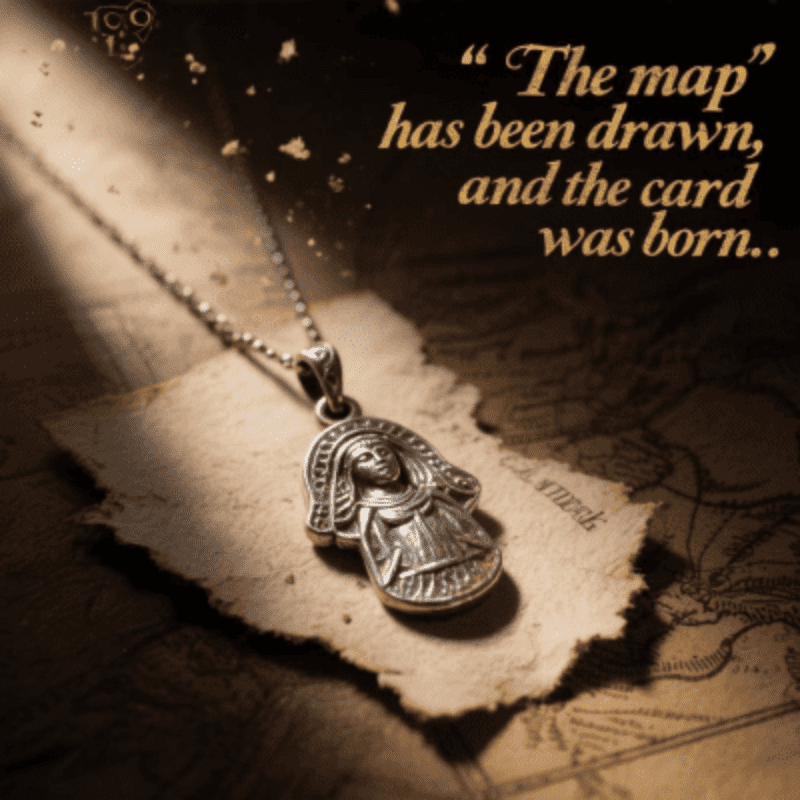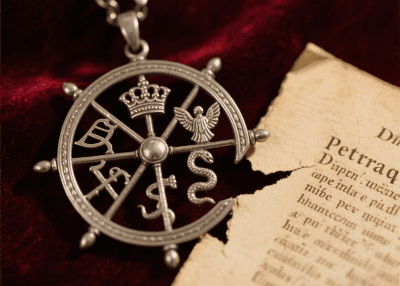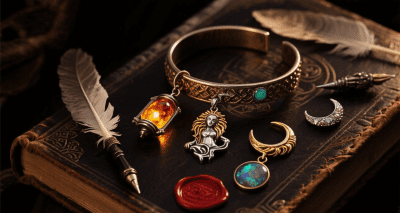The Secret History in Your Pocket: How Tarot’s Ancient Whispers Became Wearable Wisdom


Description: Extreme close-up on the “Wheel of Fortune” charm. Oxidized silver forms an intricate, slightly asymmetrical wheel – echoing early woodcut imperfections. Tiny symbols (crown, angel, serpent) are hand-engraved on each spoke. Beside it, a fragment of Francesco Petrarca’s poetry shows faded ink and paper fibers. Lighting: single raking light from left, casting dramatic shadows that mimic chiaroscuro manuscript illumination. Background: deep burgundy velvet. Focus: texture contrast between metal and aged paper.
We shuffle cards under cafe lights, seeking guidance for love or career. But centuries ago, in candlelit Italian palazzos, those same images weren’t fortune-tellers – they were philosophical flashcards. Forget Hollywood mysticism; Tarot’s true origin is a Renaissance brainchild, born where poetry, art, and political satire collided. Imagine wealthy patrons commissioning lavish painted decks (carte da trionfi – “cards of triumphs”) not to predict futures, but to debate life’s big themes: Power (The Emperor), Love (The Lovers), Chaos (The Tower). Each card was a conversation starter, a mirror reflecting human nature’s timeless dramas.

Description: The complete bracelet artfully coiled atop an aged leather book cover embossed with faux-alchemical symbols. Visible charms: “The Hermit” lantern glowing with resin-infused amber light, “Strength” featuring a woman gently holding a lion (oxidized silver with gold leaf mane highlights), “Moon” crescent inlaid with labradorite. Background: dark walnut desk surface with scattered quill nibs and sealing wax droplets. Lighting: warm, low-angle ambient glow mimicking candlelight. Style: Dark academia meets artisan jewelry.
From Parlor Game to Soul Mirror
How did Tarot evolve from aristocratic pastime to global phenomenon? Three key turns:
-
The Gypsy Myth (18th Century): Romanticized tales linked Tarot to Roma travelers – adding exotic allure but obscuring its Italian roots. Suddenly, cards felt ancient and nomadic.
-
Occult Reinvention (19th Century): Groups like the Hermetic Order of the Golden Dawn reinterpreted cards through Kabbalah and astrology, layering esoteric symbolism (e.g., Hebrew letters on The Fool).
-
Psychology’s Embrace (20th Century): Carl Jung saw Tarot as a map of the collective unconscious – archetypes (The Hero, The Shadow) universal to human experience. The “reader” became a therapist guiding self-reflection.

Description: A person’s wrist extended toward a fog-drenched forest path. The bracelet rests loosely, charms catching dawn light: “Death” transformed into a phoenix rising from ashes (silver wings outstretched), beside a vibrant crimson maple leaf. Background: blurred pine trees and golden mist. Mood: serene transformation, cyclical renewal. Focus: the phoenix’s hope-filled silhouette against nature’s decay.
Why Wear Your Archetype?
Modern Tarot jewelry isn’t about divination; it’s about carrying a compass for the soul. Each major arcana symbol holds distilled wisdom:
-
The High Priestess: Wear her crescent moon when you need intuitive clarity – she whispers, “Trust your gut.”
-
The Tower: Its lightning-struck spire isn’t doom – it’s a badge for courageous upheaval. Wear it while quitting a toxic job.
-
The Star: Her poured waters promise hope after chaos. A talisman for healing.
Introducing The Archetype Anklet
This isn’t costume jewelry. It’s medieval manuscript meets modern minimalism:
-
22 Major Arcana: Choose your life-chapter charms – from The Fool’s journey-starter to The World’s completion.
-
Material Alchemy: Oxidized silver recalls antique mirrors; resin-infused elements (The Sun’s citrine glow, Temperance’s blue chalices) add luminous depth.
-
Hidden Codes: Engrave your charm’s reverse with a personal mantra or date – your secret sigil.
Your Turn to Draw a Card…
“I wear ‘The Hermit’ during exams. His lantern doesn’t give answers – it reminds me I already have the light.”
**– Lena, Berkeley**
“Gave ‘The Lovers’ to my sister marrying across cultures. Not romance – the card’s about choices. Perfect for her brave yes.”
**– Marco, NYC**



I bought the Archetype Anklet for “The Star” charm—a grad school survival talisman. But the real magic happened when I read this blog. Learning Tarot began as Italian carte da trionfi (Renaissance debate flashcards!) transformed how I wear it. Now when my “Hermit” charm taps my anklebone during deadlines, I don’t just feel comfort—I imagine 15th-century scholars arguing fate vs free will over wine. History makes symbolism breathe.
The craftsmanship stuns. My “High Priestess” crescent moon holds resin-infused moonlight that glows in dim libraries, while oxidized silver recalls medieval mirrors. I added “The Tower” after leaving my toxic job—its lightning bolt now a badge of courage that jingles when I walk toward better things.
Surprising practicality: The 22-charms don’t tangle, and labradorite in “The Moon” flashes blue/grey like real moonlight. My therapist loves it: “Which archetype needs attention today?” becomes our session starter.
Wearing wisdom beats wearing trends. When colleagues ask about the anklet, I share Petrarch’s poetry instead of horoscopes. Suddenly, my ankle’s whispering 600 years of human drama—and we’re all players in the deck.